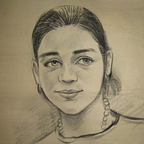Remembering the Lost Sculptures of Kathmandu: A Second Life for the Tatwa with Joy Lynn Davis
(Text and Photographs by Veneeta Singha)
The Nepal Art Council brings to life summary versions of our artistic heritage and socio-cultural realms in qualitatively valid ways. A visual narrative works best with a complementary visual profile and polemic. Our spatial culture, too, has been recorded as though in a tapestry. Extant preoccupations with revivalism and revisionism can be seen in the Council’s exhibition space and programs. Borrowing from the dystopian conversation, creative intelligence in Nepal is memory-based. Remembrance follows suit.
The world of symbol, deity, divinity and the anthropomorphic man and woman is a fable and an everyday detail here. Infused with stories of tatwa, tantra and timbral perfection, the stone sculpture is both a historical and contemporary phenomenon. A form must breathe life into a place and intellectual habitat just as the latter must refract the same principles.
An occurrence of art theft drives home the sudden loss of artistry and vision. The work itself is a testament, often, to a communal heritage that Nepal wishes it had not pushed to the annals of history as a crime. A sculpture is so much more than the form we ascribe to it. The sculptor is, by the same token, so much more than a keeper of good faith. The artist who painstakingly ‘repatriates’ a stolen sculpture and places it, even imaginatively, in its original space is certainly much more than a post-modern dealer in interesting artifacts of another place, another time, another awareness.
Tantric subjectivity and existential motifs spell mystery and mysticism. Earth, wind, fire, rain and other elements are components of both elaborate empyreans and bare human necessities. Indeed, an aerial view is best captured when the lighting is amenable. In the interest of longevity, we can and must propose that a sculpture and an investigation into its past, present and future are part of a dialogue brought to bear on dispersed life. The physical world remains, also, an omnipresent continuation to many and an uncomplicated encumbrance to others. Joy Lynn Davis’ documentary and artistic works disclose to us that, in a world of stratified complexity, the lost sculpture is very much a lost precedence which could have otherwise morphed the way ahead without confusion and uncertainty.
Places covered in Davis’ project are in and around Kathmandu City. Bhaktapur, Dhulikhel, Patan, Sankhu, Pharping and Sanga are historic towns which have helped mold and continue to define the region. Davis began her research in 2010 and the project comprises paintings, interviews and photographic documentation. Art theft in Nepal became visible in the 1960s with traceable ties to the international art trade. Lost Hindu and Buddhist sculptures in these towns have been extensively researched and contextually replaced. A tol, a totem, a textual detail all find an irreplaceable storyline in Davis’ repatriations. A Maha Lakshmi stone sculpture, traced back to the 14th Century, was stolen in 1985 from Panchadevala Chowk in Pashupati. Joy Lynn Davis’ response to our broken cultural links is a reawakening. Narrated as artistic depictions, the sculpted stories will bear witness to Nepal’s civilizational ideals and transfigured spiritual archeology.
